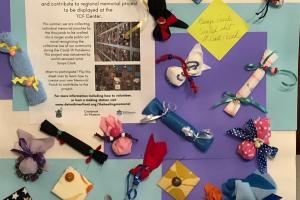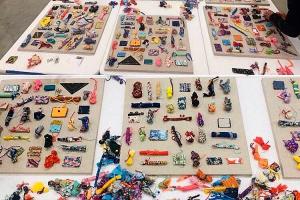Detroit's Healing Memorial comes together one pouch at a time to process COVID
Wednesday, August 25, 2021
Detroit— The pouches come in all shapes and sizes — squares, rectangles and taffy-shaped. Some are adorned with ribbon or beads. Others are in ornate fabric.
But it's what's inside each pouch that makes them unique: a message handwritten by each maker. It could be a message of grief, loss, hope or even optimism.
Eventually, the pouches — made by residents and artists from all over Detroit since mid-June — will be mounted together on panels to create one large one-of-a-kind installation called the Healing Memorial. The memorial, created to pay tribute to the losses Detroiters have endured during the COVID-19 pandemic, will be installed at the TCF Center on Aug. 31 on Detroit's Day of Healing.
An art project, called the Healing Memorial, consists of thousands of pouches that have been made across the city of Detroit with a message written by each pouch maker inside.
"In the end, it becomes a huge kind of mosaic," said Laura Mott, senior curator of contemporary art and design at the Cranbrook Art Museum, which has been collaborating on the memorial with the Detroit Riverfront Conservancy and the city of Detroit. "It’s really beautiful and very moving to have this wall of these people's intentions and wishes."
The memorial, conceived by Massachusetts artist Sonya Clark, a Cranbrook Academy of Art graduate, is a way to use art to attempt to process all the city has been through during the pandemic and what it's still experiencing, organizers say.
More than 1,000 pouches have been created at making stations all over the city and at Cranbrook, many of them coordinated by the Riverfront Conservancy. And the plan is to continue to add to the memorial even after its TCF installation.
Sister Nancyann Turner, a nun with the Adrian Dominican Sisters who retired last year, made 16 pouches for the memorial — 14 for her fellow sisters who died of COVID last year and two for children she knew who died. In each one, Turner, a quilter, tucked a prayer or little letter to bless each person's memory.
"As soon as I started doing it, I felt such peace," said Turner, who said losing her fellow sisters was even harder because they couldn't have funerals. "I felt a calmness, or a rightness. Besides the gratitude for each of these lives, it was trying to do something with my grief — something constructive — and hoping that all of this struggle will somehow make us a better people."
For the Riverfront Conservancy, the memorial is about helping the community remember people they've lost, their survivors and a way to "mark that moment in a meaningful way," said Mark Wallace, president and CEO of the conservancy.
"As everyone knows, the past year and a half has been very difficult for our community," Wallace said. "Detroit was hit particularly hard — in terms of personal loss, jobs, instability. ... These prayers, remembrances assembled together, it just hits you. You can’t help but think about each person who each one of those represents."
The memorial will be installed exactly one year after a moving display of some of Detroit's COVID-19 victims on Belle Isle was installed during the city's first Memorial Day. Enlarged photos of more than 900 Detroiters who died from the virus between March and mid-August last year were posted around the park as a memorial to their families and loved ones. As of Monday, nearly 2,500 Detroit residents have died from the virus.
Dolores Slowinski, a fiber artist from Detroit, remembers driving around Belle Isle with her husband last August to see the billboard-sized pictures when they saw a photo of her husband's friend, Daniel Blacha.
"My husband had gone to high school with Dan and had not seen Dan since college," Slowinski said. "We were stunned."
So when Slowinski heard about the Healing Memorial and the pouches that were being made in memory of loved ones, "the first pouch I made was in Dan's memory," said Slowinski.
In fact, Slowinski has made several pouches for the memorial. She's also hosted friends such as Turner and artists from all over Metro Detroit in her Detroit studio throughout the summer to make their own.
"Some people who came to work talked about their experiences of loss," said Slowinski. "Others were silent. But everyone gave the work their undivided attention."
Volunteers with the Healing Memorial, Jarie Ruddy, working on a packet, with Tessa Stein at the Manistique Street Sidewalk Festival in Detroit earlier this month.
Wallace said the idea for the Healing Memorial came about after he and Rochelle Riley, Detroit's director of arts and culture, were talking about ways to pay tribute to those the city has lost when they connected with Mott from Cranbrook. Mott suggested Clark, a well-known fiber artist who has a history of creating collaborative community art projects.
The Healing Memorial is very similar to Clark's Beaded Prayer project that she started in 1999. Like the pouches of the Healing Memorial, it includes more than 5,000 beaded prayers made by community members with handwritten messages inside. Inspired by African amulet traditions, the exhibition has traveled all over the country.
Clark said amulet traditions date back through a variety of cultures and religions. She said the Akan people in Ghana have amulets called bansuri. The Hausa and Yoruba people of Nigeria make tira and the Bakongo people in the Congo make minkis.
Clark, now an art professor at Amherst College in Massachusetts, said it's the sealed message that makes these amulets so powerful.
The memorial, created to pay tribute to the losses Detroiters have endured during the COVID-19 pandemic, will be installed at the TCF Center on Aug. 31 on Detroit's Day of Healing.
"For the amulets that contain writings, it is the presence of the word, not the ability to read it, that yields their power," Clark said.
Slowinski remembers sitting down with a woman from Henry Ford Hospital at a making station on Juneteenth — the day the project launched — and how nervous she was about making a pouch.
"She told me how for the first few months she went home every night and cried and cried and cried," remembers Slowinski. "Her job was to interpret medical test results. She felt self-conscious working with fabric and thread because I seemed so adept at it. I assured her that the contents of her piece were more important than what it looked like."
Boisali Biswas, a mixed media fiber artist from West Bloomfield Township, made 15 pouches for the memorial, which she discovered through Slowinski. She lost her first mentor to COVID and she has many friends and family in India who've been affected by the virus.
"COVID has hit us so hard, all of us," Biswas said. "... At one point, every day I was seeing somebody or the other affected by it."
Wallace of the Riverfront Conservancy said one of the biggest challenges with COVID has been the isolation of the virus and how it has affected the grieving process. He hopes the Healing Memorial helps people feel more connected.
"I hope it serves as a good reminder of the people who came before us and a good reminder that our community is special," he said.
And it's about bringing Detroit together for "active healing," said Mott from Cranbrook.
"Having a destination for people to visit and to have that collective experience — that’s the power of what art can do," Mott said. "What’s different than having an artist making a mural is this is something that everyone participates in. This is made by the hands of thousands. Even just the knowledge that you’re looking at all of these people’s wishes, desires, dedications. That’s the real beauty."
The Healing Memorial
To be unveiled Aug. 31 at the TCF Center and to stay in place through fall 2022.
More making stations will be held and pouch submissions will be accepted so the memorial will continue to grow.



